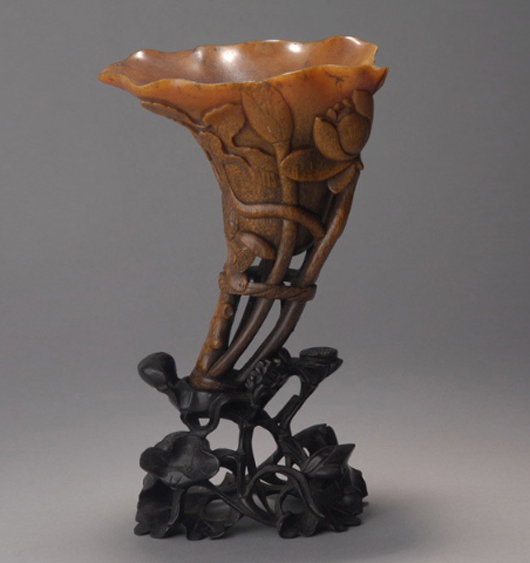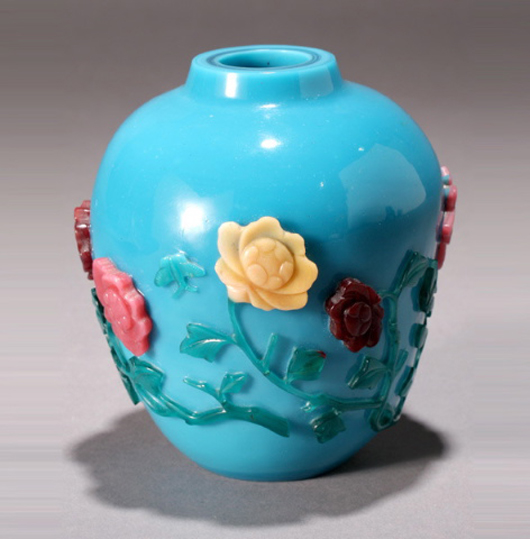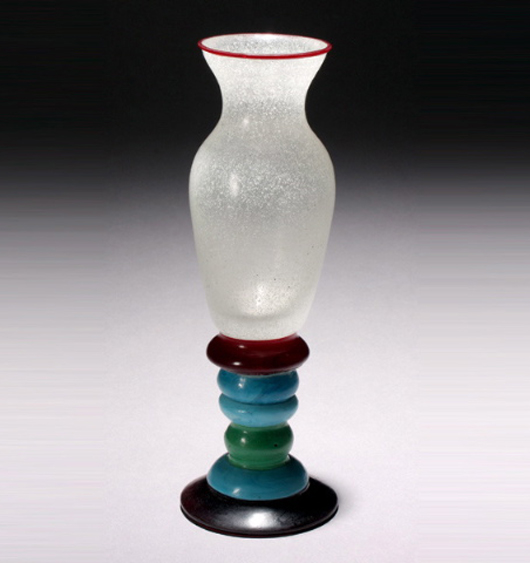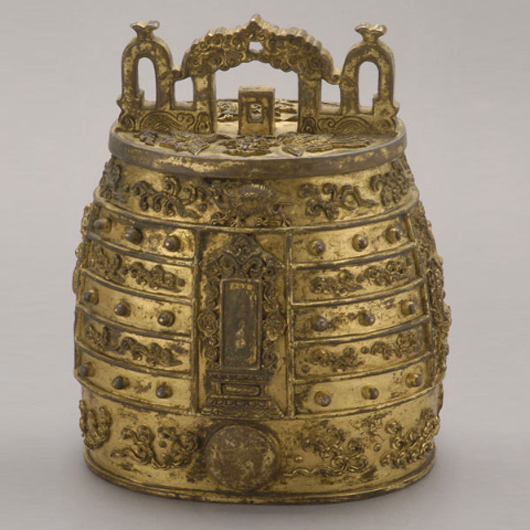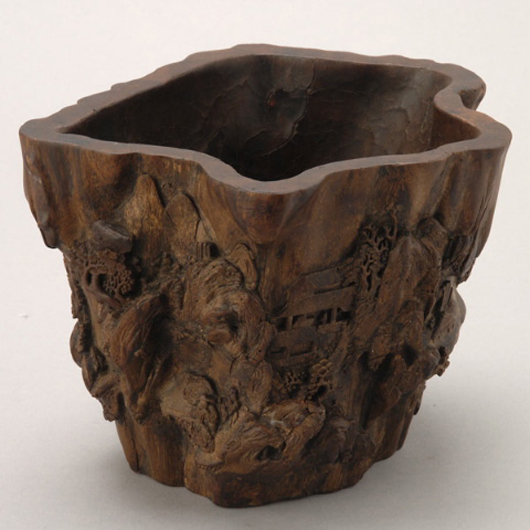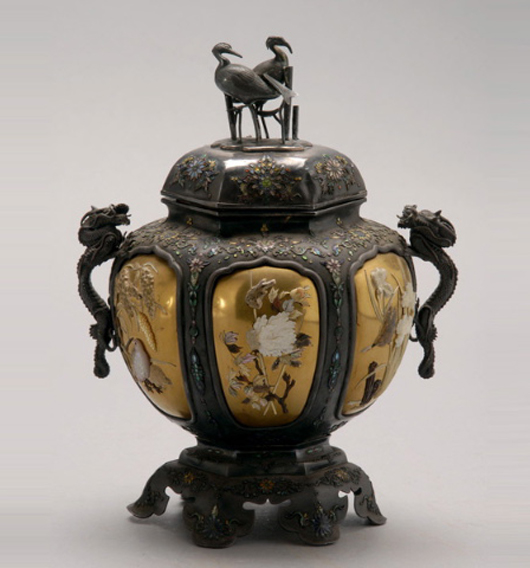Finely carved rhinoceros horn ‘lotus’ libation cup, 17th-18th century. Estimate: $40,000-$60,000. Michaan’s Auctions image.
LiveAuctioneers.com will provide Internet live bidding for the 400-lot auction, which will begin at 10 a.m. PDT.
The libation cupis an extraordinary testament to the traditional art form. It is one of those rare objects whose intrigue and value continue to attract many different types of collectors, progressively reaching new levels of value, importance and desirability. Rhino horn works are estimated at a total number of less than 4,000 worldwide. The scarcity of these works of art as well as the rhino itself explains why well-preserved rhinoceros horn carvings of the finest craftsmanship are extremely sought after in today’s market. Rhinoceros horn carvings have been historically regarded as national treasures and the rhino horn itself as one of the most precious materials known to man.
The exquisitely carved cup from the 17th to 18th century is fashioned in the form of a furled lotus leaf. A ribbon-tied cluster of high-relief lotus flowers with lotus leaves, seed pods, lychee fruits and branches issue from elegant reticulated stalks at the base of the piece. The horn displays an overall deep, rich honey tone whose highly polished surface holds a beautiful luster as well. The cup is then held by a custom made reticulated lotus theme hardwood stand, lovely complement to the masterwork. Measuring 6 1/2 inches in height and weighing 219 grams, the cup is a substantial piece in stature as well.
Acquired in Hong Kong in the 1970s by a private Los Angeles collector is an exceptional gilt-bronze archaistic ritual bell (lot 8136, $20,000-$30,000). The bell displays a rare decorative scheme that makes it an unusual find. It appears that only two other comparable examples are known; one sold at Christie’s, London on March 29, 1966 as lot 171 and the other sold at Sotheby’s, Paris on June 9, 2010 as lot 43.
Bells of this type were known as bianzhong and were usually assembled in graduated sets of 16, providing 12 musical tones with the four repeated notes in lower or higher octaves. They were also suspended in two tiers of eight attached to tall wooden frames. This arrangement is depicted in a court painting by Guiseppe Castiglione titled Imperial Banquet in Wanshu Garden (illustrated by Chuimei Ho and Bennet Bronson, Splendors of China’s Forbidden City, The Field Museum, Chicago, p. 52, pl. 42). The bells were arranged in accordance to their thickness and their respective musical note. An example of such a set is illustrated in Life in the Forbidden City of Qing Dynasty (The Forbidden City Publishing House, 2007, p. 50, no. 50, see fig. 1).
These bells were also essential in conducting Confucian ritual ceremonies at the Imperial altars, at formal banquets and during military processions. In 1741, Qianlong set up a music division for court music and specified melodies for various court functions prevailed into the early 20th century (op. cit., the Field Museum, p. 52).
Michaan’s Auctions is pleased to have the opportunity to present a third offering of fine Chinese glass from the Ina and Sandford Gadient Collection. The 13 lots for sale reflect over forty years of the Gadient’s passion for the sophisticated art form. Recognized as some of the most prominent Chinese glass collectors in the world, their pieces have been exhibited nationally as well as internationally. Their glassworks are also held in permanent museum collections at the Corning Museum of Glass in New York, the Lowe Museum at the University of Miami, Florida, the Norton Museum in West Palm Beach, Fla., the Honolulu Academy of Art in Hawaii and the Lentz Center of Asian Culture at the University of Nebraska, Lincoln. The quality and variety of their glass acquisition sets the collection above many others and includes rare pieces from Ming and earlier dynasties.
The collection is largely based on the Gadients’ diligent study and careful, focused selection of glass from the United States and abroad. The Gadients typically followed their own research conclusions when choosing pieces, but occasionally sought expert advice before securing major acquisitions. One of their primary advisers was Dr. Clarence Shangraw who served as chief curator emeritus at the San Francisco Asian Art Museum for many years. Shangraw’s expertise and guidance helped form the couple’s outstanding glass group and in turn he discussed the Gadient Collection in his essay, “Treasures of Chinese Glass Workshops.”
Highlighting the Gadient Collection lots are three glassworks from the late Qing Dynasty, each exceptional in their own right. Lot 8078 is a four-color overlay-decorated blue glass jar, displaying superb carving workmanship. The bulbous body is adorned with fine yellow, pink and red roses blossoming from lush, translucent green branches. Butterflies flutter among the blooms, set upon a backdrop of exquisite turquoise glass ($13,000-$18,000). Lot 8080 is a bottle vase bearing the Qianlong mark, vibrantly shaded in a turquoise-blue hue. The multiple layers of lively blue glass display a varying translucence, creating a remarkably beautiful effect ($13,000-$18,000).
From the same period is lot 8076, an imperial yellow lotus flower bowl ($4,000-$6,000). The lotus is regarded as an auspicious symbol, carrying strong significance in the Asian culture and Buddhism. When this flower, recognized as one of the Eight Sacred Symbols, is used in Buddhist art the representation conveys a message of purity. The structure of the plant also carries meaning with its dense root and abundant blossoms, seen as signifying prosperity and a strong, solid foundation. The brilliantly hued bowl features layers of incised lotus petals cradled by an undulating lotus leaf rising from the foot of the bowl. The bowl is also accompanied by a finely carved wood stand depicting a lotus pond.
Sure to pique strong collector interest from the Gadient offerings is a rare “snowstorm” multicolored, tiered glass vase. The lower body of the baluster form is speckled with shades of aubergine, turquoise and green glass. The mouth of the rim is an opaque aubergine as well, complementing and echoing the color scheme. A four-character Daoguang reign mark is evident upon the base and the piece measures slightly over 8 inches in height. It has also been recognized as being quite similar to a choice vase held in the collection of the Palace Museum, Beijing. Although not identical, it is noteworthy that many striking, comparable characteristics parallel the two pieces (lot 8081, $3,000-$5,000).
The breadth of the June Fine Asian Works of Art Sale is evidenced in the selection of offered lots, presenting a valuable opportunity for Michaan’s clients to add a variety of top-tier pieces to their collections. Lots include a rare aloeswood brushpot (lot 8185, $6,000-$8,000), huanghuali folding chairs (lots 8335, 8336, $4,000-$6,000 each lot), a silver Pancharaksha Kalachakra mandala (lot 8104, $4,000-$6,000), a yellow-glazed vase with Jiaqing mark from a prominent San Francisco estate (lot 8262, $10,000-$15,000), Pu Ru (1896-1963) pair of small paintings (lot 8376, $3,000-$5,000) and an enamel decorated silver Shibayama Koro with cover (lot 8396, $3,000-$5,000). The caliber of the property in the sale is sure to entice bidders from around the world and draw interest from personal collectors and dealers alike.
For general inquiries about the auction email info@michaans.com or phone 510-740-0220. Michaan’s Asian art department contacts are Harry Huang, specialist, ext. 135, harry@michaans.com; and Kim Jee, manager, ext. 111, kim@michaans.com.
ADDITIONAL LOTS OF NOTE
Finely carved rhinoceros horn ‘lotus’ libation cup, 17th-18th century. Estimate: $40,000-$60,000. Michaan’s Auctions image. Four-color overlay-decorated blue blass jar, early 19th century. Estimate: $13,000-$18,000. Michaan’s Auctions image. Rare ‘snowstorm’ and multicolor tiered glass vase, Daoguang mark and period. Estimate: $3,000-$5,000. Michaan’s Auctions image. Exceptional and rare gilt-bronze archaistic ritual bell, Qianlong period. Estimate: $20,000-$30,000. Michaan’s Auctions image. Rare large aloeswood brush pot, 18th century. Estimate: $6,000-$8,000. Michaan’s Auctions image. Enamel-decorated silver Shibayama koro and cover, Masatoshi mark, Meiji period. Estimate: $3,000-$5,000. Michaan’s Auctions image.